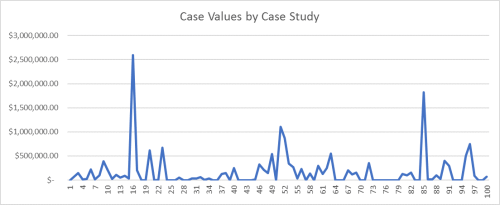Exploring 100 broken femur jury trial cases across the State of Florida, we found five high-value outliers in our data set. For this sample, we categorized any case value over $700,000 as an outlier due to the set’s case value distribution trend, or the trend in the values that most case values stick to. The outliers specific to this data set are as follows: $750,000, $875,000, $1.11 million, $1.82 million, and $2.59 million dollars. The distribution of values in the sample can be seen in Figure 1; each specific outlier can be seen in the peaks of Figure 1.

Figure 1. In this line graph, you can see the outliers of the sample data indicated by the high peaks of each high-value case.
In technical terms, statistical outliers can be telling of values that go far above the normal values seen in a given data set; chiefly, outliers call a researcher to give attention to that data value to figure out why that value would deviate from the normal trend of values. For our purposes, outliers call anyone analyzing jury verdict research to a case to look at the details of that case and to read closer into those facts to determine the threshold for why some cases receive higher verdicts in a jury trial setting than another analogous case. High-value outliers should also be analyzed in terms of their ability to skew the average of a data set from their extraordinarily high value, so it’s important to always calculate averages with and without the outliers for the most representative average of a data set.
Of all 100 cases in this sample, we calculated an average case value, including defense verdicts and outliers, of $171,059.56. Comparing this to our lowest outlier of $750,000, we found a difference of $578,940.44. Comparing it to our highest outlier of $2.59 million dollars, we found a difference of $2,418,940.44.
To exemplify the idea of jury verdict research outliers in this sample, let’s look these high-value cases from the sample:
Case Study 18 presented us with a 62-year-old male plaintiff whose trial took place in 2004 in Miami-Dade County. This case showed our highest case value of $2.59 million dollars, and began when the plaintiff was unloading his trunk when a negligent valet employee of the co-defendant struck him with a vehicle on the driveway of the defendant hotel. The plaintiff suffered a femur fracture with ligament damage, and he will eventually require a knee replacement in the future. In this case, the plaintiff contended that the defendants were negligent in their failure to properly train the valet drivers and to provide safe area in the front driveway. The defendants denied liability, but the jury found them 100% negligent. Getting injured to the point of requiring a future knee replacement that you may not have needed is grounds for a higher-than-average award amount.
Looking at Case Study 53, we saw a 37-year-old male whose trial took place in 2000 in Broward County. This plaintiff suffered a femur fracture, chondromalacia, and a lumbar strain when his vehicle was struck head-on by the defendant when the defendant attempted to make a left turn at an intersection. The plaintiff alleged that the defendant failed to yield the right-of-way, causing the collision. This case was resolved by a true plaintiff’s verdict in the amount of $1.11 million dollars. The defendant admitted liability, which may have led to a higher case value. Moreover, the plaintiff had two secondary injuries, chondromalacia and a lumbar strain, which also may have helped the award get so high.
In Case Study 54, we saw a 23-year-old male plaintiff who received a total compensatory award of $875,000 after he suffered a left femur fracture requiring surgery with scarring and resulting in permanent impairment and the need for a future hip replacement. The plaintiff had been struck while riding a motor scooter by the defendant’s vehicle when she changed lanes. The defendants took responsibility for the accident; however, they argued the amount of damages claimed, and that the plaintiff failed to wear a helmet, thus contributing to his injuries.
Moreover, Case Study 87 involved a motor vehicle accident in which the plaintiff sustained a broken femur after the defendant, Florida Power & Light, allegedly parked their truck in front of a stop sign blocking the co-defendant’s view, ending in a collision between the co-defendant’s vehicle and the plaintiff’s. The plaintiff claimed a 30% disability to his whole body and had eyewitnesses that backed up the story of the defendant’s vehicle blocking the stop sign. The defendant entered testimony of its driver claiming that the stop sign was not blocked from view. They also claimed that the plaintiff was exaggerating the extent of his impairment. The jury awarded the plaintiff $1.82 million dollars, $1.5 million of which was for pain and suffering.
Finally, Case Study 98 presented us with a 61-year-old female plaintiff in Miami-Dade County whose case was settled pre-trial in 2005. In this case, the plaintiff suffered a femur fracture requiring surgery when she slipped and fell on wet carpet at a restaurant owned and maintained by the defendants. The plaintiff was a customer in the restaurant. She alleged that the defendants failed to routinely inspect and properly maintain the premises, allowed the carpet to remain wet for an unreasonable length of time, and failed to remedy or warn of the known dangerous location. The defendants denied liability and disputed the nature of the plaintiff’s injuries. This case was resolved through a pre-trial settlement in the amount of $750,000. While this case constituted our lowest outlier, it still was out of the trend of the normal data in the sample. This case may have settled for such a high amount due to the plaintiff requiring surgery for her injuries.
To learn more about the value attributed to all broken femur cases, please click here.
If you’re a potential client, or an attorney seeking a second opinion, and would like to discuss the value of your case please feel free to call us anytime at (850)-244-


